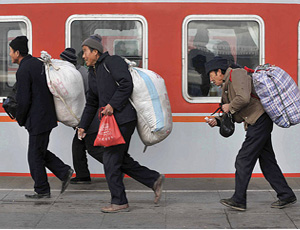Hukou System Reform Key to China’s Economic and Social Stability
By Cory Lam
 Jul. 12 – With reforms in several areas on the agenda, many commentators have noted that the Chinese household registration system, more commonly known as the hukou system, may in fact be a key hurdle in the Chinese government’s plan to diversify workforce and achieve steady long-term economic growth.
Jul. 12 – With reforms in several areas on the agenda, many commentators have noted that the Chinese household registration system, more commonly known as the hukou system, may in fact be a key hurdle in the Chinese government’s plan to diversify workforce and achieve steady long-term economic growth.
The current hukou system and its concept, which has largely remained unchanged since the late 1950s, typically restricts a Chinese national from relocating freely in the mainland by defining a set province of residence for a Chinese citizen and placing limitations on the amount of economic and social benefits available to that citizen outside of this geographical area. Examples of these limitations include restricted access to subsidized public housing, education, health care, pension and unemployment benefits, all crucial factors to take into account should one decide to move to another locale in search of employment, for instance. Furthermore, many cities have set up preferential policies where non-local residents are banned from buying property or applying for vehicle registrations, making it even more difficult for workers to relocate.
Taking things to the extreme, earlier this year new regulations were passed in Beijing prohibiting home purchases for those who cannot provide adequate proof that social security and taxes have been paid in the city for five whole consecutive years. Hukou statuses are categorized into rural hukous or urban hukous, the status of which often being the only thing separating the migrant workers from the locals in terms of political or social treatments received. These classifications are generally inherited from one’s parents and therefore cannot be changed easily without government approval.
The hukou system was initially set up as a means to control the potential surge of migrants from rural to urban areas, during a time when China’s economy was developing rapidly and growth was somewhat concentrated on the east coast around major business hubs like Shanghai, Beijing and Guangzhou. However, given that the new Five Year Plan places significant emphasis on addressing migrant worker issues in the country, many critics have voiced concerns that this model is no longer viable for the new direction of growth that China is pursuing. In a report published in April, the American Chamber of Commerce in China predicted that “population shifts will provide a structural impetus for wages to grow faster than real GDP in the medium term. However, the household registration (hukou) system and inequity of social welfare between urban and rural areas will continue to limit the flexibility of the labor market.”
In order for China to continue their quest for a balanced development throughout the country’s vast geographical regions, retaining quality and educated workforces in the right places will be a key concern for the country’s leaders and employers alike. As the government continues to concentrate their efforts on developing the western and central regions in China, the current trends actually indicate that more rural workers are opting to stay in their hometowns due to rising living costs in large cities and to avoid the hassles of living without an urban hukou – at the same time allowing them to stay closer to their families.
Ironically, the larger cities are now hoping to reverse this phenomenon by consistently raising minimum wages and offering urban hukou status to select individuals, although the idea behind this would not be new. Previously, wealthy individuals had already been able to purchase an “urban” hukou under the “blue stamp” policy – a population management scheme set up by the Chinese government back in 1992. Almost 20 years on from that date, Shanghai is now hoping to attract young migrant workers between the ages of 25 to 35 to the financial capital, in order to “replenish a labor pool that has begun drying up” in a rapidly aging population coupled with low birth rates, stated Xie Lingli, a director of the Shanghai Municipal Population and Family Planning Commission. It is predicted that by the year 2015, there would be an almost 8 percent drop in the availability of able workforce in the city. But not only does the hukou status affect the benefits received by the employees, this is also a pressing issue for the employers, who are ultimately responsible for covering the employees’ urban social insurance.
Local regions in China are now also looking to abolish the hukou and its implications, with the city of Chengdu being one of the firsts to announce a pilot program eliminating the differences between an urban and rural hukou. There is also speculation that China’s central government is planning to create the world’s largest urban area in the Pearl River Delta by connecting no less than nine cities together, which would no doubt have some impacts on the hukou system.
As the 12th Five Year Plan plans to “ensure and improve the people’s well-being” as well as to “promote long-term, steady and rapid economic development and social harmony and stability,” providing the appropriate means for citizens to become more mobile socially and geographically within the country would have to become more of a priority than it had previously done in the past. Given the complexity of this historical system and its effects on local economies and administrations, it is unlikely that it can be completely removed in the near future. However, the Chinese government will have to do more than just include “hukou reform” on its agenda year after year and needs to start bringing about real practical changes in order to remove this notion of having “second-class citizens” in Chinese cities.
Related Reading
Getting Your Employees a Hukou – An Unavoidable HR Issue in China
The Evolution of China’s Communist Party, 90 Years in the Making
- Previous Article The China Alternative – Myanmar
- Next Article China Renewable Energy Industry Update: Jul. 12



























